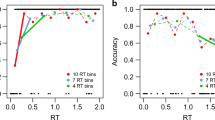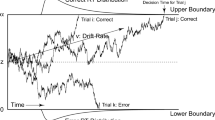Abstract
While standard joint models for response time and accuracy commonly assume the relationship between response time and accuracy to be fully explained by the latent variables of the model, this assumption of conditional independence is often violated in practice. If such violations are present, taking these residual dependencies between response time and accuracy into account may both improve the fit of the model to the data and improve our understanding of the response processes that led to the observed responses. In this paper, we propose a framework for the joint modeling of response time and accuracy data that allows for differences in the processes leading to correct and incorrect responses. Extensions of the standard hierarchical model (van der Linden in Psychometrika 72:287–308, 2007. https://doi.org/10.1007/s11336-006-1478-z) are considered that allow some or all item parameters in the measurement model of speed to differ depending on whether a correct or an incorrect response was obtained. The framework also allows one to consider models that include two speed latent variables, which explain the patterns observed in the responses times of correct and of incorrect responses, respectively. Model selection procedures are proposed and evaluated based on a simulation study, and a simulation study investigating parameter recovery is presented. An application of the modeling framework to empirical data from international large-scale assessment is considered to illustrate the relevance of modeling possible differences between the processes leading to correct and incorrect responses.







Similar content being viewed by others
Notes
Since these models only consider observed RT, the latent variable in the measurement model for RT only captures response speed: The degree to which a person displays the tendency to provide responses quickly rather than slowly. This tendency should not be equated with cognitive speed (however defined exactly).
For clarification it may be relevant to point out that each of these approaches models conditional dependence between RA and RT, which may arise due to many sources and need not be reducible or even linked to a speed–accuracy trade-off (Bolsinova, Tijmstra, Molenaar, & De Boeck, 2017b). Hence, none of these approaches specifically attempt to model the speed–accuracy trade-off.
Note that van der Linden and Glas (2010) considered a constrained version of the one-factor model in which the factor loadings of all items are equal to 1, and the variance of the speed latent variable is freely estimated.
Since we do not include any strong prior information in the estimation of the parameters, the posterior means would be very close to the maximum likelihood estimates, meaning that the difference between both the AIC and mAIC and the BIC and mBIC can be expected to be minimal.
For each item the responses were divided in bins based on RTs with 5 s per bin. The proportions of correct responses were computed per bin. The lower bound of the first bin in which the proportion of correct responses was above zero was used a threshold for disengaged responses. In total, 8.35% of the observed responses were flagged as disengaged.
This measure is aimed at capturing the possible differences between the RTs of correct and incorrect response in how strongly they are correlated among each other, and hence whether depending on RA the RTs show stronger or weaker structural patterns.
References
Albert, J. (1992). Bayesian estimation of Normal Ogive item response curves using Gibbs sampling. Journal of Educational Statistics, 17, 251–269. https://doi.org/10.2307/1165149.
Birnbaum, A. (1968). Some latent trait models and their use in inferring an examinee’s ability. In F. M. Lord & M. R. Novick (Eds.), Statistical theories of mental test scores (pp. 395–479). Reading: Addison-Wesley.
Bolsinova, M., De Boeck, P., & Tijmstra, J. (2017). Modelling conditional dependence between response time and accuracy. Psychometrika, 82(4), 1126–1148.
Bolsinova, M., & Tijmstra, J. (2016). Posterior predictive checks for conditional independence between response time and accuracy. Journal of Educational and Behavioral Statistics, 41(2), 123–145.
Bolsinova, M., & Tijmstra, J. (2018). Improving precision of ability estimation: Getting more from response times. British Journal of Mathematical and Statistical Psychology, 71(1), 13–38.
Bolsinova, M., Tijmstra, J., & Molenaar, D. (2017a). Response moderation models for conditional dependence between response time and response accuracy. British Journal of Mathematical and Statistical Psychology, 70(2), 257–279.
Bolsinova, M., Tijmstra, J., Molenaar, D., & De Boeck, P. (2017b). Conditional dependence between response time and accuracy: An overview of its possible sources and directions for distinguishing between them. Frontiers in Psychology, 8, 202. https://doi.org/10.3389/fpsyg.2017.00202.
Gelman, A., Meng, X., & Stern, H. (1996). Posterior predictive assessment of model fitness via realized discrepancies. Statistica Sinica, 4, 733–807.
Goldhammer, F., Martens, T., Christoph, G., & Lüdtke, O. (2016). Test-taking engagement in PIAAC. OECD Education Working Papers, (133). https://doi.org/10.1787/5jlzfl6fhxs2-en
Hoff, P. D. (2009). A first course in Bayesian statistical methods. New York: Spinger. https://doi.org/10.1007/978-0-387-92407-6.
Klein Entink, R., Fox, J., & van der Linden, W. J. (2009). A multivariate multilevel approach to the modeling of accuracy and speed of test takers. Psychometrika, 74, 21–48.
Klein Entink, R., van der Linden, W. J., & Fox, J.-P. (2009). A Box–Cox normal model for response times. British Journal of Mathematical and Statistical Psychology, 62(3), 621–640.
Lord, F., & Novick, M. (1968). Statistical theories of mental test scores. Reading, MA: Addison-Wesley.
Meng, X. B., Tao, J., & Chang, H. H. (2015). A conditional joint modeling approach for locally dependent item responses and response times. Journal of Educational Measurement, 52, 1–27. https://doi.org/10.1111/jedm.12060.
Meng, X.-L. (1994). Posterior predictive p-values. The Annals of Statistics, 22(3), 1142–1160.
Molenaar, D., Tuerlinckx, F., & van der Maas, H. (2015a). A bivariate generalized linear item response theory modeling framework to the analysis of responses and response times. Multivariate Behavioural Research, 50, 56–74. https://doi.org/10.1080/00273171.2014.962684.
Molenaar, D., Tuerlinckx, F., & van der Maas, H. (2015b). A generalized linear factor model approach to the hierarchical framework for responses and response times. British Journal of Mathematical and Statistical Psychology, 68, 197–219. https://doi.org/10.1111/bmsp.12042.
OECD. (2012). Literacy, numeracy and problem solving in technology-rich environments. Paris: OECD Publishing. https://doi.org/10.1787/9789264128859-en.
Partchev, I., & De Boeck, P. (2012). Can fast and slow intelligence be differentiated? Intelligence, 40, 23–32. https://doi.org/10.1016/j.intell.2011.11.002.
Ranger, J., & Ortner, T. (2012). The case of dependency of responses and response times: A modeling approach based on standard latent trait models. Psychological Test and Assessment Modeling, 54, 128–148.
Rouder, J. N., Sun, D., Speckman, P. L., Lu, J., & Zhou, D. (2003). A hierarchical bayesian statistical framework for response time distributions. Psychometrika, 68(4), 589–606.
Scherer, R., Greiff, S., & Hautamäki, J. (2015). Exploring the relation between time on task and ability in complex problem solving. Intelligence, 48, 37–50.
Semmes, R., Davison, M. L., & Close, C. (2011). Modeling individual differences in numerical reasoning speed as a random effect of response time limits. Applied Psychological Measurement, 35(6), 433–446.
Tanner, M., & Wong, W. (1987). The calculation of posterior distributions by data augmentation. Journal of the American Statistical Association, 82, 528–540. https://doi.org/10.2307/2289457.
van der Linden, W. J. (2006). A lognormal model for response times on test items. Journal of Educational and Behavioural Statistics, 31, 181–204. https://doi.org/10.3102/10769986031002181.
van der Linden, W. J. (2007). A hierarchical framework for modeling speed and accuracy on test items. Psychometrika, 72, 287–308. https://doi.org/10.1007/s11336-006-1478-z.
van der Linden, W. J. (2009). Conceptual issues in response-time modeling. Journal of Educational Measurement, 46(3), 247–272.
van der Linden, W. J., & Glas, C. A. W. (2010). Statistical tests of conditional independence between responses and/or response times on test items. Psychometrika, 75(1), 120–139. https://doi.org/10.1007/s11336-009-9129-9.
van der Linden, W. J., Klein Entink, R. H., & Fox, J. P. (2010). IRT parameter estimation with response times as collateral information. Applied Psychological Measurement, 34, 327–347. https://doi.org/10.1177/0146621609349800.
van der Maas, H. L., & Jansen, B. R. (2003). What response times tell of children’s behavior on the balance scale task. Journal of Experimental Child Psychology, 85(2), 141–177.
van der Maas, H. L., & Wagenmakers, E.-J. (2005). A psychometric analysis of chess expertise. The American journal of psychology, 118, 29–60.
Van de Schoot, R., Lugtig, P., & Hox, J. (2012). A checklist for testing measurement invariance. European Journal of Developmental Psychology, 9(4), 486–492.
Wang, C., Chang, H. H., & Douglas, J. A. (2013a). The linear transformation model with frailties for the analysis of item response times. British Journal of Mathematical and Statistical Psychology, 66(1), 144–168.
Wang, C., Fan, Z., Chang, H. H., & Douglas, J. A. (2013b). A semiparametric model for jointly analyzing response times and accuracy in computerized testing. Journal of Educational and Behavioral Statistics, 38(4), 381–417.
Zhan, P., Jiao, H., & Liao, D. (2017). Cognitive diagnosis modelling incorporating item response times. British Journal of Mathematical and Statistical Psychology, 71, 262–286.
Author information
Authors and Affiliations
Corresponding author
Additional information
Publisher's Note
Springer Nature remains neutral with regard to jurisdictional claims in published maps and institutional affiliations.
Electronic supplementary material
Below is the link to the electronic supplementary material.
Rights and permissions
About this article
Cite this article
Bolsinova, M., Tijmstra, J. Modeling Differences Between Response Times of Correct and Incorrect Responses. Psychometrika 84, 1018–1046 (2019). https://doi.org/10.1007/s11336-019-09682-5
Received:
Revised:
Published:
Issue Date:
DOI: https://doi.org/10.1007/s11336-019-09682-5




